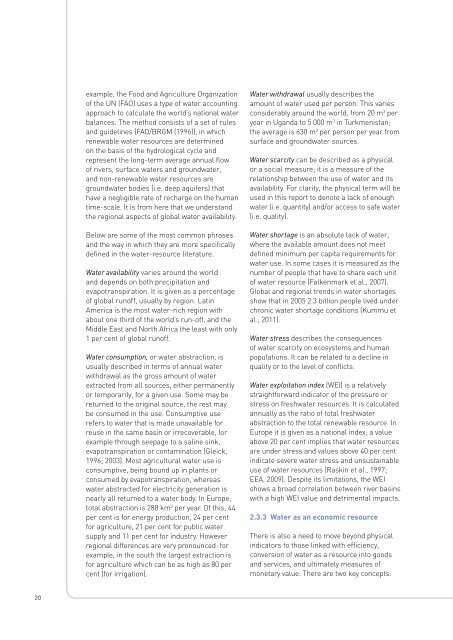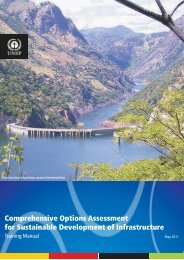MEASURING WATER USE IN A GREEN ECONOMY - UNEP
MEASURING WATER USE IN A GREEN ECONOMY - UNEP
MEASURING WATER USE IN A GREEN ECONOMY - UNEP
You also want an ePaper? Increase the reach of your titles
YUMPU automatically turns print PDFs into web optimized ePapers that Google loves.
example, the Food and Agriculture Organization<br />
of the UN (FAO) uses a type of water accounting<br />
approach to calculate the world’s national water<br />
balances. The method consists of a set of rules<br />
and guidelines (FAO/BRGM (1996)), in which<br />
renewable water resources are determined<br />
on the basis of the hydrological cycle and<br />
represent the long-term average annual flow<br />
of rivers, surface waters and groundwater,<br />
and non-renewable water resources are<br />
groundwater bodies (i.e. deep aquifers) that<br />
have a negligible rate of recharge on the human<br />
time-scale. It is from here that we understand<br />
the regional aspects of global water availability.<br />
Below are some of the most common phrases<br />
and the way in which they are more specifically<br />
defined in the water-resource literature.<br />
Water availability varies around the world<br />
and depends on both precipitation and<br />
evapotranspiration. It is given as a percentage<br />
of global runoff, usually by region. Latin<br />
America is the most water-rich region with<br />
about one third of the world’s run-off, and the<br />
Middle East and North Africa the least with only<br />
1 per cent of global runoff.<br />
Water consumption, or water abstraction, is<br />
usually described in terms of annual water<br />
withdrawal as the gross amount of water<br />
extracted from all sources, either permanently<br />
or temporarily, for a given use. Some may be<br />
returned to the original source, the rest may<br />
be consumed in the use. Consumptive use<br />
refers to water that is made unavailable for<br />
reuse in the same basin or irrecoverable, for<br />
example through seepage to a saline sink,<br />
evapotranspiration or contamination (Gleick,<br />
1996; 2003). Most agricultural water use is<br />
consumptive, being bound up in plants or<br />
consumed by evapotranspiration, whereas<br />
water abstracted for electricity generation is<br />
nearly all returned to a water body. In Europe,<br />
total abstraction is 288 km 3 per year. Of this, 44<br />
per cent is for energy production, 24 per cent<br />
for agriculture, 21 per cent for public water<br />
supply and 11 per cent for industry. However<br />
regional differences are very pronounced: for<br />
example, in the south the largest extraction is<br />
for agriculture which can be as high as 80 per<br />
cent (for irrigation).<br />
Water withdrawal usually describes the<br />
amount of water used per person. This varies<br />
considerably around the world, from 20 m 3 per<br />
year in Uganda to 5 000 m 3 in Turkmenistan;<br />
the average is 630 m 3 per person per year from<br />
surface and groundwater sources.<br />
Water scarcity can be described as a physical<br />
or a social measure; it is a measure of the<br />
relationship between the use of water and its<br />
availability. For clarity, the physical term will be<br />
used in this report to denote a lack of enough<br />
water (i.e. quantity) and/or access to safe water<br />
(i.e. quality).<br />
Water shortage is an absolute lack of water,<br />
where the available amount does not meet<br />
defined minimum per capita requirements for<br />
water use. In some cases it is measured as the<br />
number of people that have to share each unit<br />
of water resource (Falkenmark et al., 2007).<br />
Global and regional trends in water shortages<br />
show that in 2005 2.3 billion people lived under<br />
chronic water shortage conditions (Kummu et<br />
al., 2011).<br />
Water stress describes the consequences<br />
of water scarcity on ecosystems and human<br />
populations. It can be related to a decline in<br />
quality or to the level of conflicts.<br />
Water exploitation index (WEI) is a relatively<br />
straightforward indicator of the pressure or<br />
stress on freshwater resources. It is calculated<br />
annually as the ratio of total freshwater<br />
abstraction to the total renewable resource. In<br />
Europe it is given as a national index; a value<br />
above 20 per cent implies that water resources<br />
are under stress and values above 40 per cent<br />
indicate severe water stress and unsustainable<br />
use of water resources (Raskin et al., 1997;<br />
EEA, 2009). Despite its limitations, the WEI<br />
shows a broad correlation between river basins<br />
with a high WEI value and detrimental impacts.<br />
2.3.3 Water as an economic resource<br />
There is also a need to move beyond physical<br />
indicators to those linked with efficiency,<br />
conversion of water as a resource into goods<br />
and services, and ultimately measures of<br />
monetary value. There are two key concepts:<br />
20

















